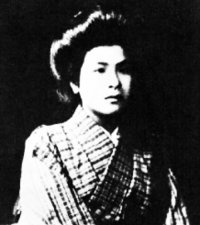- Noe Ito
-
Noe Itō 
Born January 21, 1895
Fukuoka, JapanDied September 16, 1923 (aged 28)
Tokyo, JapanSpouse Jun Tsuji Noe Itō (伊藤 野枝 Itō Noe, born January 21, 1895 in Fukuoka, Japan; died September 16, 1923) was a Japanese anarchist, social critic, author and feminist.
Contents
Biography
Itō graduated from Ueno Girls' High School in Ueno, Tokyo, and joined the Bluestocking Society (Seitō-sha; 青鞜社), producer of the feminist arts and culture magazine Seitō (青鞜) in 1912. Ito wrote social criticism and novels, and translated writings of Emma Goldman (Emma Goldman, The Tragedy of Woman's Emancipation, New York, Mother Earth Publishing Association, 1906, etc.).
In the summer of her fifth-year at Ueno Girls' High School, under her uncle's management, she was married to a man named Fukutaro. Itō agreed to the marriage because Fukutaro had just returned from America, where she hoped to go. She confided in her sister that when they reached America she would run off and leave him. That never happened, and they remained in Japan. Itō's displeasure with the arrangement deepened when her husband could not support her educational interests, which was a part of the wedding arrangement.
When she started to attend Ueno, she formed a friendship with her English teacher, Jun Tsuji. He had been her confidante during her marriage. Tsuji allowed Itō to stay with him when she was to be sent back home with her husband, which would have disrupted her education. With Tsuji's support she continued her education and eventually ended her marriage with Fukutaro. Itō and Tsuji began a romantic relationship, and quickly married. They eventually had two sons: Makoto and Ryūji. Their relationship lasted about four years before she was captivated by Sakae Ōsugi.
Starting in 1916, she lived and worked with Ōsugi, where she continued to rise in the feminist group and showed growing leadership potential. On September 16, 1923, in the chaos immediately following the Great Kantō earthquake, Itō, Ōsugi, and his 6 year old nephew were arrested, beaten to death and thrown into a well by a squad of military police led by Lieutenant Masahiko Amakasu. Noe Itō was 28 years old.
The killing of such high profile anarchists, along with a young child, became known as the Amakasu Incident, and sparked surprise and anger throughout Japan. Kijū Director Kijū Yoshida made Eros Plus Massacre (エロス+虐殺) in 1969, about Sakae Ōsugi, in which Ito features prominently.
References
- This article incorporates text from OpenHistory.
Further reading
- Setouchi, Harumi (2005). Beauty in Disarray. trans. Sanford Goldstein and Kazuji Ninomiya. Boston: Tuttle Publishing. ISBN 0804833222. A fictional account of Ito's life.
External links
- Biography of Noe Ito on libcom.org
- The life of Noe Itou (Harumi Setouchi's novel Bi wa rantyou ni ari at Fukuoka Prefectural Itoshima High School)
- Noe Ito on www.spock.com
Categories:- 1895 births
- 1923 deaths
- Japanese anarchists
- Japanese feminists
- Anarcha-feminists
- Murdered anarchists
- Japanese writers
- Feminist writers
- Writers from Fukuoka (city)
- Free love advocates
Wikimedia Foundation. 2010.
